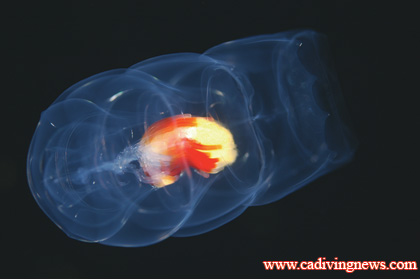As we head out of San Diego’s Mission Bay on a bright and sunny day, it’s the ocean conditions that will determine the dive site today. If conditions aren’t just right it will mean a kelp forest or wreck dive. There’s nothing wrong with that, but what we are hoping for is a dive experience that is quite a bit different, an open ocean dive! What we’re looking for way out in the “Big Blue,” isn’t fish or mammals, but pelagic invertebrates.
Conditions are looking good today, with two of the three required needs for a dive like this, flat seas and sunshine. On the trip out we are escorted by large pods of dolphin that play in our bow wake. On other trips we’ve stopped to see mola molas, whales, submarines and have even been visited by Homeland Security.
After about ten miles of travel, I stop the boat for a look-see. Nothing, darn! But wait, I catch a glimpse of a ghostly object drifting by; this looks like a good place to check out.
Most divers rarely spot these weird creatures close to shore. If we are lucky we hope to encounter many different types, but you just never know, it is often hit or miss. As I put up the dive flag and suit up, other passing boats must think we’re crazy! I can imagine what they must be thinking. What are these idiots doing “scuba diving” way out here?
Pelagic invertebrates come in all shapes and sizes, some have the common, beautiful shapes of jellyfish, and while others have shapes only a sci-fi writer could create. Many are lacking bright colors, except for a small slash of color from their insides or from reflected light. Some drift by with very little motion, while others can be quite active, swimming by flapping what looks like wings. There are animals like jellyfish and comb jellies that drift by alone, while others can be found attached to each other to form chains or groups of animals. Still others called Corolla calceola “fly” pass like butterflies. There are even creatures featuring shells. Small crustacean can often be seen inside some creatures, while small shrimp sometimes swim about the water column.
Photographing these strange creatures can be quite challenging. A macro lens like a 60mm works well for a lot of these creatures, although focusing can be difficult at times. Because of a lack of contrast, a focusing light is a must. A wide-angle lens can also be used with the close focus technique, as some subjects are a little too big for macro, causing the photographer to back too far away. I chose to use two strobes one off each side, but you must experiment to see what works best for you.
This type of diving must be considered advanced. Buoyancy control is extremely important. As there is no visual reference, a diver can easily ascend or descend very rapidly and receive serious injuries or worse. It is usually not physically demanding as you are not swimming great distances, but you never know. You must keep in mind, however, that you are usually quite a few miles offshore, and if something goes wrong, help can take quite awhile to arrive. Also keep an eye on the ocean conditions as they can change rapidly. Safety equipment, such as signaling devices for both the divers and the boat and a marine radio is a must, along with all equipment required by the Coast Guard.
This type of diving and photography can be very frustrating, as well as very rewarding. More often than not you will plan on going out to so-called “Blue Water” and get skunked, having to find an alternate dive site. It is the experience of diving and photographing these strange and beautiful creatures that makes all the effort and frustration worthwhile.









